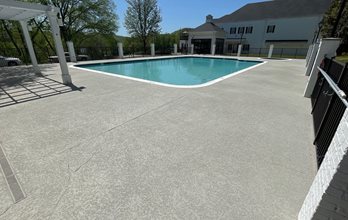Concrete Crack Repair in Nashville & the Surrounding Areas
Explore effective techniques for repairing cracks in concrete surfaces such as patios, driveways, pool decks, and more.
Although concrete is known for its durability, it’s still prone to cracking. Fortunately, when cracks appear, replacing the entire surface isn’t necessary. Repairs and concrete resurfacing often provide a more efficient and cost-effective solution.
Get a free quoteWHY DOES CONCRETE CRACK?
There are various reasons concrete may crack. Poor mixing or improperly installed control joints can lead to cracks over time. Even well-installed concrete can develop cracks due to environmental conditions. While concrete is strong, it doesn’t handle tension or bending well, making it susceptible to cracking under stress. Freeze-thaw cycles can also exert pressure that leads to cracks.
COMMON TYPES OF CONCRETE CRACKS
The method of repair depends on the type of crack. Before proceeding, it’s crucial to assess the crack's type and severity. Here are common types of cracks and ways to address them:
Hairline cracks
These small cracks occur due to natural shrinkage as concrete cures. Although they don’t typically indicate structural issues, they should be repaired to prevent water from seeping in.
Repair tip: Apply crack filler or adhesive to seal the crack.
Shrinkage cracks
Larger than hairline cracks, these often appear in irregular patterns and result from rapid drying or an improper water mix.
Repair tip: Use crack filler or adhesive to stop further spreading. Resurfacing may be needed for larger cracks.
Settlement cracks
Settlement cracks happen when the ground beneath the slab isn’t compacted properly or if weight is applied before the concrete has fully cured, often creating uneven surfaces.
Repair tip: Minor settlement cracks can be fixed by grinding and sealing. Larger cracks may require resurfacing or replacement.
Structural cracks
These are the most serious, typically deep and wide, and often result from poor reinforcement or shifting foundations.
Repair tip: For severe structural cracks, replacing the slab may be the most effective long-term solution.
IDENTIFYING THE CAUSE OF YOUR CONCRETE CRACKS
It’s important to determine the root cause of your concrete cracks before starting repairs so you can help prevent future damage. Cracks can result from environmental factors like moisture and freeze-thaw cycles, poor installation, or external issues like tree roots. If the issue is due to inadequate reinforcement, surface repairs alone won’t suffice. A professional contractor can assess the problem and recommend the appropriate solution. Learn more about our concrete repair services.
 At the Governor’s Club in Brentwood, TN, SUNDEK of Nashville resurfaced the cracked pool deck using Classic Texture and the Custom Scoreline Effect to create a beautiful, durable surface.
At the Governor’s Club in Brentwood, TN, SUNDEK of Nashville resurfaced the cracked pool deck using Classic Texture and the Custom Scoreline Effect to create a beautiful, durable surface.REPAIR OPTIONS FOR CRACKED CONCRETE
At SUNDEK of Nashville, we offer several repair options tailored to the type and severity of the crack:
- Custom Scoreline Effect: This technique, developed by SUNDEK, turns existing cracks into part of the surface’s new design, converting them into functional expansion joints.
- Crack Repair and Resurfacing: After repairing individual cracks, resurfacing the entire slab ensures a uniform look.
- Remove and Replace: In cases of severe cracking, repair might not be viable. Consulting a professional to assess if replacement is necessary is often the best course of action.
Local Project: Cracking Brentwood Pool Deck Gets Resurfaced
RESURFACING: AN ECO-FRIENDLY CHOICE
If your concrete slab is structurally sound, resurfacing is a greener alternative to full replacement. It avoids the labor and cost of demolition while also avoiding having to dispose of the old material. Resurfacing reuses the existing slab but gives it a fresh, updated appearance.
COST FACTORS FOR CONCRETE REPAIR
Repair costs vary depending on the crack's size and severity. Minor hairline cracks can often be fixed with an inexpensive crack filler. Larger or more extensive damage requires a professional assessment. SUNDEK of Nashville can evaluate the damage and recommend the most suitable repair method for your needs.
SHOULD YOU DIY CONCRETE CRACK REPAIR?
DIY repair is possible for smaller cracks, but it’s important to use quality products and follow the right procedures to ensure long-lasting results. Poorly executed repairs can make the issue worse or lead to recurring cracks. For a durable, professional finish, it’s best to consult an experienced contractor.
Contractors Who Repair Cracked Concrete Near Me
Are you looking for a contractor to repair your concrete surface? At SUNDEK of Nashville, we serve all of Tennessee and surrounding areas, including Paducah, KY; Bowling Green, KY; and Huntsville, AL.
Call us: (615) 822-7134
Email us: [email protected]